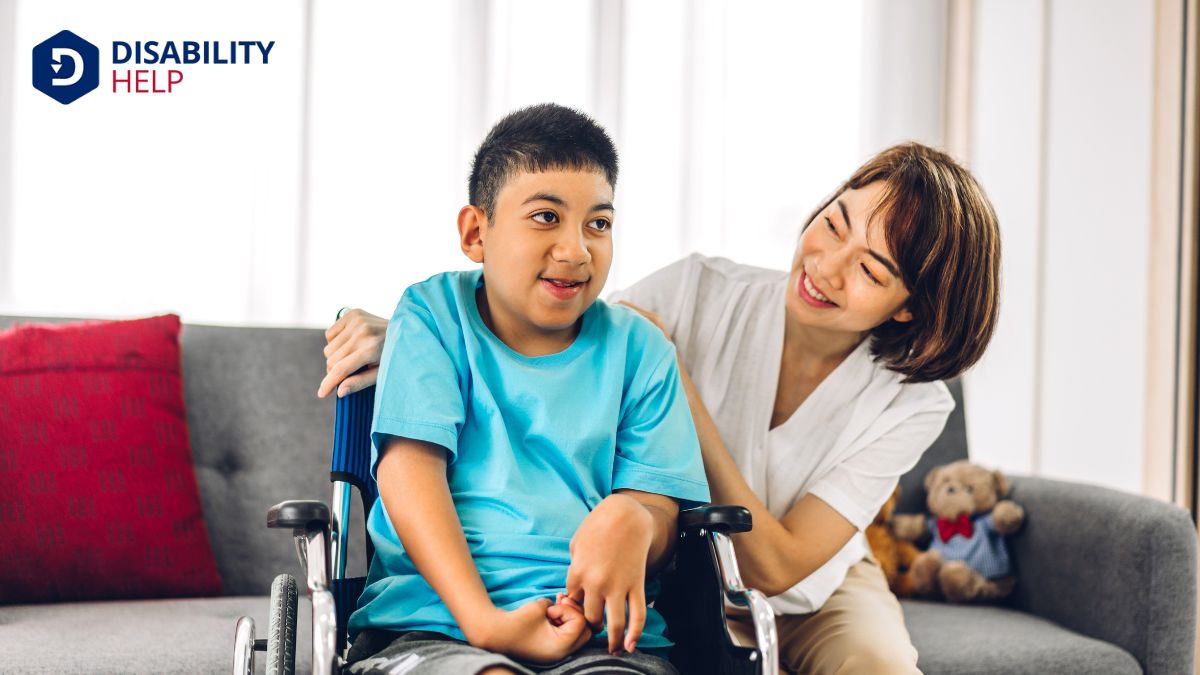The Education for All Handicapped Children ActThe 1975 U.S. law, later renamed the Individuals with Disabilities Education Act (IDEA), ensuring fr... requires public schools to provide students with disabilities equal accessThe principle that all individuals, including those with disabilities, should have equal opportunity... to education. This includes a Free and Appropriate Public Education (FAPE) through tailored Individualized Education Programs (IEPs). Schools must facilitate learning in the Least Restrictive Environment and involve parents in decision-making. It also mandates changeover services for older students, supports funding provisions, and guarantees compliance. There's much more to uncover about how this law supports every child's educational journey.
Key Takeaways
- Schools must provide Free and Appropriate Public Education tailored to the needs of students with disabilities.
- Individualized Education Programs (IEPs) must be developed collaboratively for each student with disabilities.
- Students should be educated in the Least Restrictive Environment alongside non-disabled peers when appropriate.
- Schools are required to offer special educationCustomized educational programs designed to meet the needs of students with disabilities. and related services meeting state standards.
- Federal and state oversight ensures compliance with the Act's requirements for educational access and progress.
Equal Access to Public Education
When we talk about equal access to public education, it's crucial to recognize the transformative impact of the Education for All Handicapped Children Act. This landmark legislation, enacted in 1975, opened doors for countless students with disabilities, ensuring they have the same educational opportunities as their peers.
It's acknowledged that this act was pivotal in shifting public education towards greater inclusivity and fairness. It mandated that public schools provide equal access to students with disabilities and required schools to develop tailored educational plans.
Free and Appropriate Public Education (FAPE)

Building on the foundation of equal access to public education, we now focus on the principle of Free and Appropriate Public Education (FAPE).
FAPE guarantees that every child with disabilities receives an education tailored to their unique needs without any cost to their families. It's our commitment to providing educational opportunities that enable students to make meaningful progress in school.
This principle means that schools must offer special education and related services that meet the standards set by the state.
However, it doesn't imply the best possible education or a particular program but one that allows the child to learn and grow.
Individualized Education Programs (IEPs)
Individualized Education Programs (IEPs) are vital tools in our mission to guarantee that every child with disabilities receives an education tailored to their specific needs.
These programs provide a detailed plan developed collaboratively by educators, parents, and specialists. We focus on setting realistic goals, identifying necessary services, and outlining accommodationsModifications or adjustments in healthcare settings to support patients with disabilities. to support each student's learning journey.
Creating an IEP starts with understanding the child's unique strengths and challenges, making sure we address both. Regular assessments make sure we adaptA grassroots disability rights organization in the U.S. that focuses on promoting community-based se... the plan as needed, fostering growth and development.
It's essential that we maintain open communication with families, valuing their insights and concerns. Through IEPs, we empower students by equipping them with the resources they need to succeed academically and socially.
Least Restrictive Environment
As we continue to support students with disabilities, ensuring they learn in the least restrictive environment (LRE) is essential.
LRE means students should be educated alongside their non-disabled peers to the maximum extent appropriate. This approach promotes inclusionThe practice of creating environments in which any individual or group can be and feel welcomed, res..., fostering social interactions and providing access to the general curriculum.
We recognize that each student's needs are unique, so we must carefully assess and determine the right balance between support and independence.
By adapting teaching methods and using assistive technologies, we can help students thrive in mainstream classrooms.
Our goal is to provide opportunities for meaningful participation, enhancing both educational and social development.
Let's work together to create environments where all students feel valued and empowered to reach their full potential.
Parental Involvement in Decision-Making
In our pursuit of creating inclusive learning environments, involving parents in the decision-making process is key. We recognize that parents know their children best and play an essential role in shaping their educational experiences.
When parents actively participate, we enhance the development of personalized education plans that meet each child's unique needs. The Education for All Handicapped Children Act mandates this involvement, guaranteeing parents have a voice in decisions affecting their child's education.
We work collaboratively, inviting parents to meetings and discussions regarding assessments, placements, and individualized education programs. By fostering open communication and partnership, we create an environment where parents feel valued and empowered.
Together, we can guarantee every child receives the support and opportunities they deserve.
Procedural Safeguards for Students and Parents
How do we guarantee that students and parents feel secure and informed throughout the educational process? By understanding procedural safeguards, we can make certain that both students and parents are aware of their rights and responsibilities.
These safeguards are a set of legal protections provided under the Education for All Handicapped Children Act. They aim to create transparency and fairness in decision-making about a child's education.
We must inform parents about their rights, such as access to their child's educational records and the ability to challenge decisions through due processThe legal requirement that the state must respect all legal rights owed to a person, including fair ... hearings.
It's essential that everyone knows the steps for resolving disagreements. By making certain of open communication and clear explanations, we help parents and students navigate the system with confidence and trust, fostering a supportive educational environment.
Assessment and Evaluation Requirements
When we consider the assessment and evaluation requirements under the Education for All Handicapped Children Act, it's crucial to focus on thorough individual assessments.
These assessments are conducted by multidisciplinary evaluation teams to guarantee a well-rounded view of each child's needs.
Let's also remember that parental involvement isn't just encouraged but mandated, making sure that families are active partners in this important process.
Comprehensive Individual Assessments
Before diving into the specifics of thorough individual assessments, let's understand why these evaluations are vital for the Education for All Handicapped Children Act.
They guarantee each child's unique needs are identified so they can receive an appropriate education tailored to them.
We must conduct extensive assessments to capture a full picture of a child's strengths and challenges.
These evaluations guide the development of an individualized education program (IEP)A plan developed for U.S. students with disabilities to ensure they receive tailored educational ser..., which is essential for a child's educational success.
Multidisciplinary Evaluation Teams
To guarantee a thorough understanding of each child's educational needs, we rely on multidisciplinary evaluation teams. These teams are essential for creating extensive assessments that guide tailored educational plans. Each team typically includes professionals with varied expertise, guaranteeing a well-rounded evaluation.
Imagine the impact when:
- A psychologist identifies cognitive strengths and challenges, giving insight into a child's learning processes.
- A speech therapist assesses communication skills, tailoring interventions to improve interaction.
- An occupational therapist evaluates motor skills, guaranteeing physical tasks are accessible.
- A special education teacher integrates findings, creating a personalized educational path.
Together, we guarantee no aspect of a child's development is overlooked, fostering a supportive learning environment.
When each team member contributes their expertise, we provide the best foundation for success.
Parental Involvement Mandates
While we concentrate on thorough evaluations, we can't overlook the crucial role that parents play in their child's educational journey.
The Education for All Handicapped Children Act emphasizes parental involvement as a cornerstone of a child's success. We understand parents provide unique insights into their child's needs and abilities that are invaluable during assessments and evaluations.
The Act mandates schools to actively involve parents in decision-making processes. This means we're required to notify parents about assessment plans and obtain their consent before proceeding.
We must guarantee they've opportunities to participate in meetings and discussions about their child's progress and Individualized Education Program (IEP).
Transition Services for Older Students
As students with disabilities approach the end of their high school journey, the importance of change services becomes undeniable. We must guarantee they move smoothly into adulthood.
Transition servicesServices that help individuals with disabilities move from one life stage to another, such as from s... are designed to prepare them for life beyond school, focusing on several key areas:
- Employment Opportunities: Let's equip them with skills to find meaningful work.
- Post-Secondary Education: Encourage further learning that suits their interests and abilities.
- Independent Living: Empower them to manage their daily lives independently.
- Community Participation: Enable active engagement within their communities.
These services are vital for fostering independence and confidence.
We want every student to feel capable and ready to face the future. By focusing on their unique needs, we're building a foundation for success.
Funding Provisions and Responsibilities
Securing adequate funding is essential for implementing the Education for All Handicapped Children Act effectively.
We, as a community, must guarantee schools have the resources to provide the necessary services and accommodations for every child with a disability. The Act mandates that states and local agencies share responsibility for financing these educational services. Federal funds are allocated to assist with costs, but states must also contribute considerably.
Our collective responsibility extends to advocating for sufficient budget allocations and understanding how these funds are distributed. It's vital we remain informed about financial obligations to support compliance.
Together, we can guarantee that every child receives the education they deserve by keeping funding a priority and participating actively in funding discussions.
Monitoring and Compliance Mechanisms

As we explore the monitoring and compliance mechanisms of the Education for All Handicapped Children Act, it's essential to understand how state compliance checks and federal oversight protocols guarantee adherence to the law.
Together, these processes hold schools accountable and protect the rights of handicapped children.
State Compliance Checks
While guaranteeing compliance with the Education for All Handicapped Children Act, states must establish robust monitoring and compliance mechanisms.
We recognize the importance of this task, and it's essential that every state takes it seriously to secure equitable education for all children.
Here's what states should focus on:
- Regular Audits: Conducting frequent audits guarantees schools adhere to the standards set by the Act.
- Feedback Systems: Implementing systems where parents and educators can voice concerns allows for quick adjustments.
- Training Programs: Providing ongoing training for educators guarantees they remain informed and capable of meeting students' needs.
- Transparent Reporting: Sharing findings publicly builds trust and holds schools accountable.
Each of these steps is significant in creating an inclusive educational environment.
Let's work together to guarantee no child is left behind.
Federal Oversight Protocols
Federal oversight protocols play a critical role in guaranteeing the effective implementation of the Education for All Handicapped Children Act. As we explore these protocols, we find that they include monitoring mechanisms and compliance checks.
The federal government sets guidelines to guarantee states provide appropriate educational opportunities for children with disabilities. We must understand that this involves regular evaluations and reviews of state practices.
Federal agencies, like the Department of Education, are tasked with guaranteeing states adhere to the law's requirements. They conduct audits and provide technical assistance to support compliance.
If states fail to meet standards, they may face corrective actions. Through these oversight measures, we're able to guarantee that the educational rights of all students with disabilities are protected and upheld.
Conclusion
In summary, we've explored how the Education for All Handicapped Children Act guarantees equal access to public education for all students with disabilities. It mandates Free and Appropriate Public Education (FAPE), Individualized Education Programs (IEPs), and the least restrictive environment. Parents are involved in decision-making, while assessments and evaluations guarantee progress. Changeover services aid older students and funding provisions support implementation. Monitoring and compliance keep the system accountable. Together, we're committed to an inclusive educational future.






